27.12.2020
China to launch core module of space station in first half of 2021

Zhou Jianping, chief designer of China's manned space program, attends a handover ceremony for the return capsule of the Shenzhou-10 manned spacecraft in Shaoshan, central China's Hunan Province, Dec. 25, 2020. (Xinhua/Chen Zeguo)
China plans to launch the core module of its manned space station in the first half of 2021, a senior official said Friday.
The core module will be sent by a Long March-5B Y2 rocket from the Wenchang Spacecraft Launch Site in Hainan Province, said Zhou Jianping, chief designer of China's manned space program, at a handover ceremony for the return capsule of the Shenzhou-10 manned spacecraft in Shaoshan, central China's Hunan Province.
"Subsequent space missions include the launches of Tianzhou-2 cargo craft and Shenzhou-12 manned craft after the core module is sent into orbit," Zhou said.
Tests on the core module have been completed, and astronaut training is underway. The astronauts will carry out a number of extravehicular activities.
China is scheduled to complete the construction of the space station around 2022. The construction project will be implemented in two phases. Six flight missions, including the launch of the core module, have been scheduled in the phase of key technology validation. Enditem
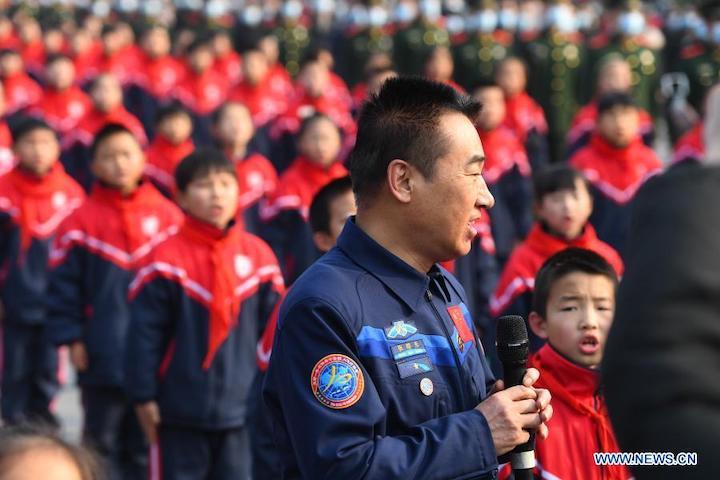
Astronaut Zhang Xiaoguang attends a handover ceremony for the return capsule of the Shenzhou-10 manned spacecraft in Shaoshan, central China's Hunan Province, Dec. 25, 2020. (Xinhua/Chen Zeguo)
Quelle: Xinhua
----
Update: 28.12.2020
.
China to launch core module of space station in first half of 2021
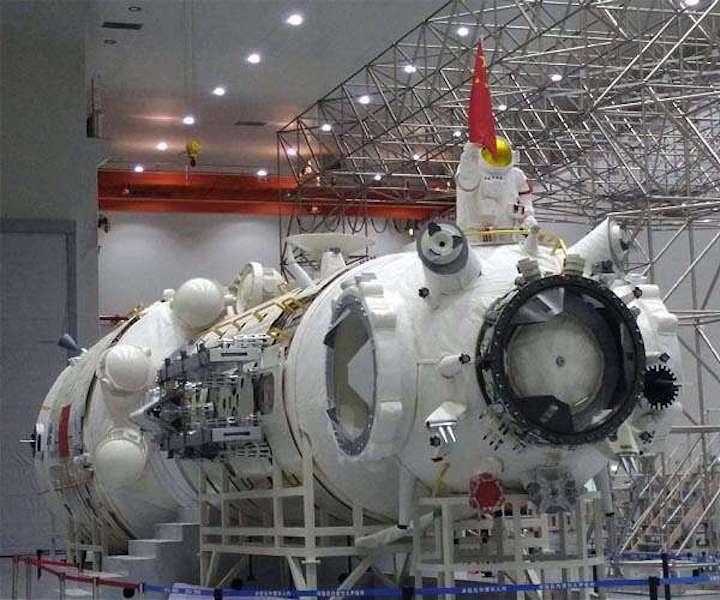
The core module of China's space station in research. [Photo/China Daily]
China plans to launch the core module of its manned space station in the first half of 2021, a senior official said Friday.
The core module will be sent by a Long March-5B Y2 rocket from the Wenchang Spacecraft Launch Site in Hainan Province, said Zhou Jianping, chief designer of China's manned space program, at a handover ceremony for the return capsule of the Shenzhou-10 manned spacecraft in Shaoshan, central China's Hunan Province.
"Subsequent space missions include the launches of Tianzhou-2 cargo craft and Shenzhou-12 manned craft after the core module is sent into orbit," Zhou said.
Tests on the core module have been completed, and astronaut training is underway. The astronauts will carry out a number of extravehicular activities.
China is scheduled to complete the construction of the space station around 2022. The construction project will be implemented in two phases. Six flight missions, including the launch of the core module, have been scheduled in the phase of key technology validation.
Quelle: SD
----
Update: 11.01.2021
.
China to begin construction of space station this year
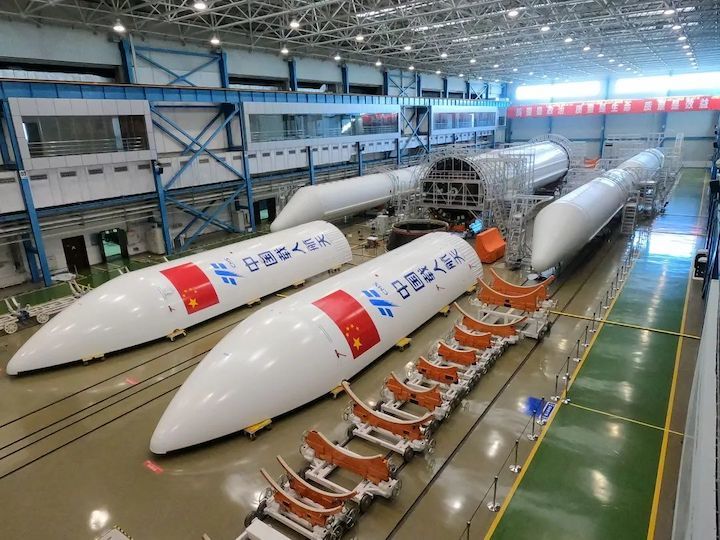
The core section of China’s space station is scheduled to launch in the next several months, the first of 11 missions carrying lab elements, cargo, and astronauts to the fledgling outpost over the next two years, according to Chinese space program officials.
The launch of the first element of the Chinese station is one of more than 40 missions scheduled this year by China Aerospace Science and Technology Corp., or CASC, China’s largest state-owned aerospace contractor.
CASC’s subsidiaries build China’s Long March rockets, manufacture satellites, and oversee construction of the Chinese space station.
The China National Space Administration, the country’s space agency, said last month that the third phase of the Chinese human spaceflight program will begin in earnest in 2021, building on earlier missions testing out the human-rated Shenzhou space transport vehicle, spacewalk procedures, and docking systems needed for building the full-scale space station.
The heavy-lift Long March 5B rocket assigned to launch the space station’s Tianhe core module has completed testing at its factory in Tianjin, China, and will soon be delivered by transport ship to the Wenchang launch base on Hainan Island.
At Wenchang, the Long March 5B rocket will be stacked on its mobile launch platform and mated with the Tianhe module, which measures more than 54.4 feet (16.6 meters) long, has a maximum diameter of around 13.8 feet (4.2 meters), and has a launch weight of roughly 49,600 pounds (22.5 metric tons).
Manufacturing and testing of the Tianhe module has also been completed in preparation for its launch this year.
Previous Long March 5 launch campaigns required about two months from the time of the rocket’s arrival at the Wenchang spaceport until liftoff. If Chinese teams follow that precedent, the Long March 5B launch with the Tianhe module could occur as soon as this spring.
The Long March 5B rocket is a variant of China’s Long March 5 rocket family tailored to haul heavy payloads into low Earth orbit.
Flying without a second stage, the Long March 5B will carry its payloads into space using just its core stage and four strap-on liquid-fueled boosters. Large payloads will occupy the second stage’s volume on the Long March 5B, which can deliver up to 55,000 pounds (25 metric tons) of payload to low Earth orbit.
The Long March 5B configuration completed its first demonstration flight in May 2020, following delays stemming from a Long March 5 launch failure in 2017 that also pushed back the schedule for launching the first element of the Chinese space station.

The 11 missions to kick off assembly of China’s space station include the three launch of three pressurized modules on Long March 5B rockets, resupply flights using Tianzhou cargo freighters launched on Long March 7 rockets from Wenchang, the Shenzhou crew capsules launched on Long March 2F rockets from Jiuquan, an inland spaceport in the Gobi Desert in China’s Inner Mongolia region.
The fully-assembled outpost will be about one-sixth the mass of the International Space Station, and is closer in size to Russia’s retired Mir station than the ISS.
China launched two Tiangong prototype space labs in 2011 and 2016.
The Tiangong 1 space lab hosted two Shenzhou crew in 2012 and 2013, and China’s most recent human spaceflight mission — Shenzhou 11 — docked with the Tiangong 2 module in 2016.
China also launched a test flight of the Tianzhou supply ship, similar in function to Russia’s Progress or SpaceX’s Cargo Dragon capsule supporting the International Space Station. The first Tianzhou freighter took off on a Long March 7 rocket in 2017 and docked with the Tiangong 2 space lab, proving out automated docking and in-orbit refueling technology.
After the Tiangong pathfinders verified key technologies for the Chinese space station, officials are moving ahead with integrating the complex in low Earth orbit a few hundred miles above Earth.
The Long March 7 rocket for the Tianzhou 2 mission, the first cargo delivery flight to the Chinese station, is undergoing final assembly in its factory, according to CASC. The Long March 2F launcher for the Shenzhou 12 crew flight is undergoing final factory tests, which should be completed soon after the Chinese New Year in February, officials said.
A specific schedule for the launches of the Tianzhou 2 and Shenzhou 12 missions were not disclosed by Chinese sources.
Chinese officials have said they have selected crew members for the Shenzhou 12 mission, and astronaut training is underway. The astronauts will carry out multiple spacewalks on their mission to link up with the Tianhe module in orbit.
CASC described the space station missions as “the top priority” on the organization’s schedule this year. Other major activities in China’s space program this year include the arrival of the Tianwen 1 robotic mission in orbit around Mars in February, setting the stage for landing of a Chinese rover on the Red Planet in the May timeframe.

In a statement previewing Chinese space program in 2021, officials also hinted at further planning for exploration of the Moon by Chinese astronauts. But the statement offered no details on the lunar mission planning, which follows China’s successful robotic sample return mission to the Moon in late 2020.
Other Chinese launches expected to add up to the more than 40 missions in CASC’s schedule this year include Long March rocket flights to deploy weather satellites, research payloads, and Chinese military spacecraft in orbit.
There are also a handful of commercial launches in CASC’s backlog, including missions to deliver batches of small Earth-imaging satellites for the Argentine company Satellogic.
Quelle: SN
----
Update: 16.01.2021
.
China's space station core module, cargo craft pass factory review
The core module of China's planned space station has passed a factory review, along with the project's Tianzhou-2 cargo craft and the core module mission products of the space application systems, the China Manned Space Engineering Office (CMSEO) said Thursday.
The completion of the factory review, conducted by experts at China's manned space program, means the construction project of the country's space station will now enter the implementation phase, the CMSEO statement said.
China is scheduled to complete the in-orbit construction of the space station around 2022, after carrying out 11 flight missions this year and next, including three launches of different modules, four launches of cargo craft and four launches of manned craft.
The core module, named Tianhe (harmony of the heavens), is scheduled for launch this spring. Enditem
Quelle: Xinhua
----
Update: 18.01.2021
.
Major space station components cleared for operations
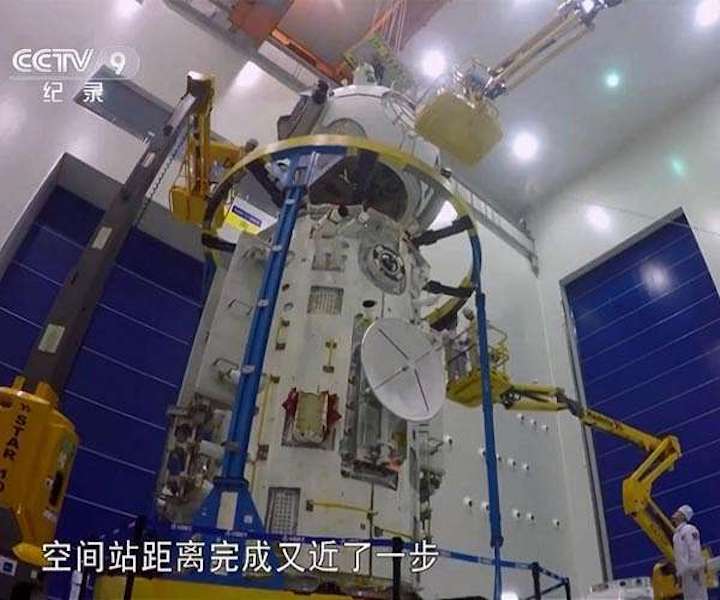
Three major components of China's space station program have passed technical and quality assessments and are ready for upcoming missions, according to the China Manned Space Agency.
Experts from the agency, the Chinese Academy of Sciences and China Aerospace Science and Technology Corp reviewed the design, construction and test reports on the space station's Tianhe core module, the Tianzhou 2 cargo spaceship and the core scientific capsule, the agency said in a statement on Thursday.
Sources close to the agency said the components will be transported to the Wenchang Space Launch Center on Hainan Island and launched into space in coming months.
China will start assembling its first space station this year, according to government plans. Major stages of the program include the Long March 5B flight this spring, tasked with transporting the station's core capsule into a low-Earth orbit; two astronaut missions to prepare the capsule for other components; and two robotic cargo flights to deliver supplies.
The core capsule, Tianhe, or Harmony of Heavens, will have three parts - a connecting section, a life-support and control section and a resources section.
It will be equipped with three docking hatches for manned and cargo spacecraft, and two berthing locations to connect with space laboratories. There will also be a hatch to launch astronauts' extravehicular activities.
The core module will be 16.6-meters long, with a diameter of 4.2 meters. It will be central to the space station's operations, given that astronauts will live there and control the entire station from it. The module will also be capable of hosting scientific experiments.
Once it becomes fully operational around 2022, the multimodule Chinese space station - Tiangong, or Heavenly Palace - will be comprised of three main components; the Tianhe capsule and two space labs, with a combined weight of more than 90 metric tons.
Quelle: SD
----
Update: 20.02.2021
.
China assembling rocket to launch first space station module
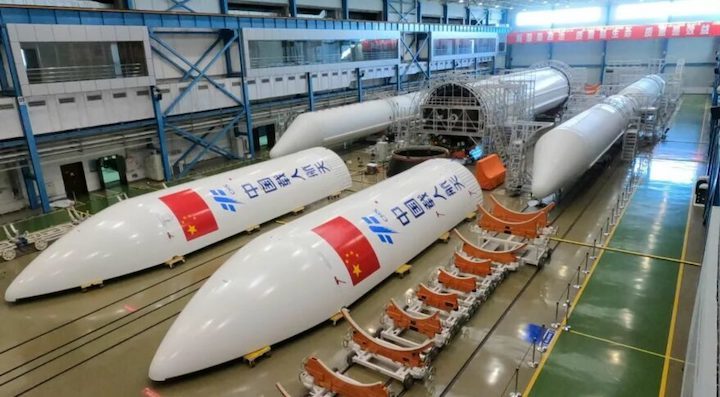
HELSINKI — The Long March 5B heavy-lift rocket to launch China’s first space station module is soon to be assembled at Wenchang for launch in April.
The China Aerospace Science and Technology Corp. (CASC) stated Thursday that the Long March 5B was headed for Wenchang, citing a Feb. 16 press release from the China Manned Space Engineering Office (CMSEO).
The 849-metric-ton Long March 5B heavy-lift rocket will launch the roughly 22-metric-ton Tianhe core module from Wenchang Satellite Launch Center following delivery, assembly, integration and testing.
Ship tracking indicates that the Xu Yang 16 cargo ship traveled from Tianjin, the northern city in which the Long March 5B components are manufactured, arriving at Qinglan harbor Feb. 16. The vessel is apparently being used instead of the dedicated Yuanwang-21 and -22 cargo ships.
China has not announced a timeframe for the mission. However previous Long March 5-series rocket launch campaigns have lasted around two months, indicating launch can be expected around mid-to-late April.
The 16.6-meter-long, 4.2-meter-diameter Tianhe core module has already been delivered to Wenchang ready for launch preparations.
Tianhe, meaning “harmony of the heavens”, is planned to be inserted directly into a low Earth orbit with an apogee of around 370 kilometers and inclined by 41 degrees.
The module will provide regenerative life support and living space for three astronauts as well as propulsion to maintain the orbit of the entire complex.
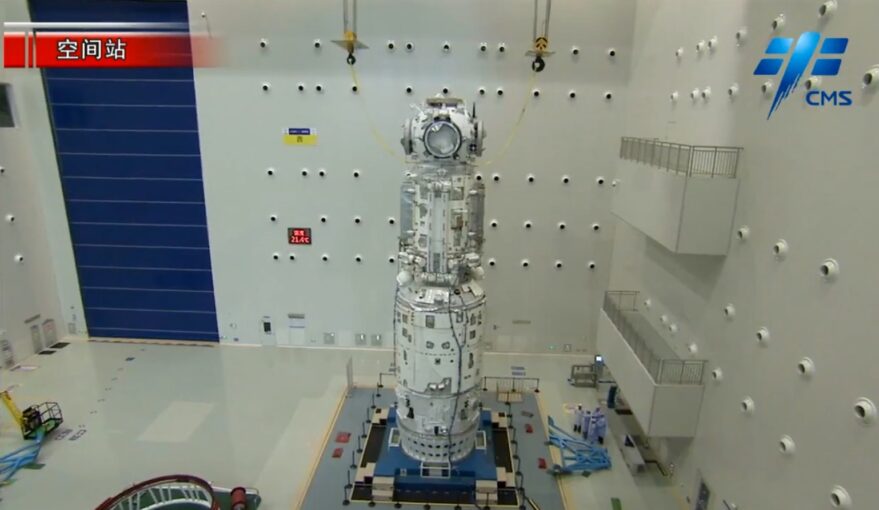
China plans to construct its space station through 11 launches carried out across 2021 and 2022. These consist of three module launches, four Tianzhou cargo missions and four crewed flights.
Launch of Tianhe is to be followed by a Long March 7 launch of the Tianzhou-2 cargo vessel to dock with, fuel and supply Tianhe. The Long March 7 is also in the final stages of preparation.
The first crewed mission, Shenzhou-12, will then launch from Jiuqun via a Long March 2F hypergolic rocket. CMSEO stated Feb. 16 that the selected crew have entered the intensive training phase ahead of the mission.
CASC states that the 12th and 13th Long March 2F rockets for launching the Shenzhou-12 and Shenzhou-13 missions are ready for action. This suggests two crewed missions in 2021, the first likely during the first half of the year.
The launch of Tianhe will mark the construction phase of the three-module low Earth orbit Chinese space station, a project approved in 1992 as part of a human spaceflight program.
Starting in 2003 China has launched six crewed missions and two testbed space laboratories in order to develop and verify a range of technologies and capabilities for the project.
The most recent was the 2016 month-long Shenzhou-11 mission to Tiangong-2 space lab. The latter was deorbited in 2018, avoiding a repeat of the uncontrolled Tiangong-1 reentry scenario.
In April 2020 carried out a test launch of the Long March 5B, debuting a prototype new generation crew spacecraft for deep space. The new, uncrewed craft was loaded with propellant to simulate a payload similar in mass to a space station module.
Notably the rocket’s large core stage reached orbital velocity and subsequently made an uncontrolled reentry off the west coast of Africa days later. A similar event can thus be expected for the launch of Tianhe and later experiment modules.
The launch of the Tianhe core module was delayed by the 2017 launch failure of the second Long March 5, postponing test launch of the Long March 5B. China is now condensing the space station construction schedule into an intensive two-year period, maintaining the target of completing the Chinese Space Station by the end of 2022.
After completion the CSS will be joined in orbit by the Xuntian optical module, a co-orbiting, Hubble-class space telescope. Xuntian will be capable of docking with the CSS for maintenance and repairs. The space station itself could also be expanded from three to six modules.
CASC is planning to carry out at least 40 launches in what would be a busiest year yet for China. The landing attempt of the Tianwen-1 Mars rover is expected in May-June, amid the Tianhe, Tianzhou and Shenzhou launches.
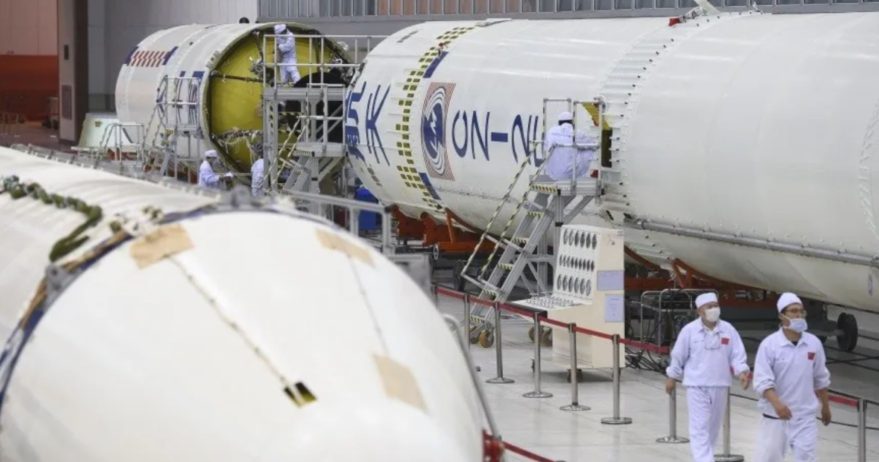
Chinese rocket for space station mission transported to launch site
The Long March-5B Y2 rocket, which is to launch the core module of China's space station, was safely transported to the Wenchang Spacecraft Launch Site in Hainan Province on Monday.
According to the China Manned Space Agency (CMSA), the rocket, along with the core module Tianhe that has been transported to Wenchang, will be assembled and tested at the launch site.
A total of 11 missions to build China's space station are planned for the next two years, including the construction of the core module that is scheduled to be launched in the first half of this year, according to the China National Space Administration.
The CMSA said that facilities and equipment at the Wenchang Spacecraft Launch Site are in good condition and preparations have been carried out as scheduled. Enditem
Quelle: Xinhua
----
Update: 3.03.2021
.
China tests high-thrust rocket engine for upcoming space station missions
A Chinese high-thrust oxyhydrogen engine designed for the Long March-5 carrier rocket has completed a 520-second test in Beijing in preparation for space station missions, the engine's maker said on Wednesday.
Developed by an institute under the China Aerospace Science and Technology Corporation (CASC), the engine is the most advanced cryogenic liquid rocket engine that has been put into use in China.
The engine ran for 520 seconds during its test on Sunday, 20 seconds longer than its designed work cycle, exhibiting the capability to extend its service life, said the CASC. It is the fifth long-range test the rocket engine has undergone, bringing its cumulative test run time to 2,520 seconds.
Xu Xiaoyong, a senior designer with the engine maker, said the Sunday test run was intended to verify the engine's performance, "so as to ensure the success of the upcoming Long March-5B Y2 rocket launch missions."
The Long March-5B carrier rocket will be used to launch different modules for China's planned manned space station. The core module is scheduled for launch this spring.
The CASC said it would conduct three further 500-second tests to further improve the engine's reliability. Enditem
Quelle: Xinhua
----
Update: 13.04.2021
.
Chinese rocket for space station mission arrives at launch site
China's Long March-7 Y3 rocket, which will launch the cargo craft of China's space station, has arrived at its launch site in southern China's Hainan Province.
The rocket, alongside the Tianzhou-2 cargo craft that has already been transported to the Wenchang Spacecraft Launch Site, will be assembled and tested at the launch site, the China Manned Space Engineering Office (CMSEO) said on Monday.
The CMSEO said the facilities and equipment at the launch site are in good condition and preparations are being carried out as scheduled. Enditem
Quelle: Xinhua
----
Update: 14.04.2021
.
China preparing Tianzhou-2 cargo mission to follow upcoming space station launch
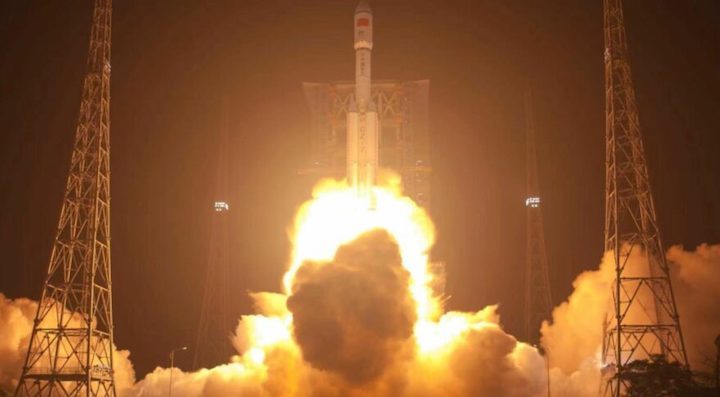
HELSINKI — A Long March 7 rocket has arrived at China’s coastal Wenchang spaceport to facilitate the Tianzhou-2 supply mission to a soon-to-launch space station module.
The delivery was announced by the China Manned Space Engineering Office Monday and is part of intense preparations for construction of a modular space station in low Earth orbit.
China is currently readying a Long March 5B rocket to launch Tianhe, aroughly 22-metric-ton spacecraft which will serve as the core space station module. That mission is expected to launch in late April.
The recently delivered Long March 7 kerosene-liquid oxygen propellant medium-lift rocket will be assembled to launch the Tianzhou-2 cargo and supply spacecraft to dock with the core module.
The Tianzhou-2 mission will provide Tianhe with propellant for maintaining its orbital altitude as well as supplies for hosting astronauts. The cargo spacecraft will have a mass of around 13,000 at liftoff, with a cargo mass of around 6,500 kilograms.
The Shenzhou-12 mission, launching on a Long March 2F rocket from Jiuquan, will subsequently send three astronauts for the Tianhe core module.
Chinese space authorities have not revealed a detailed timeline for the upcoming missions. However previous launch campaigns for the Long March 5B and Long March 7 rockets indicate the Tianhe launch is likely to take place near the end of April, with the Tianzhou-2 mission ready to go by mid-May. Shenzhou-12 could launch as soon as June.
The Long March 5B to launch the core module will be rolled out to the launch pad around a week ahead of launch. The Long March 7 will roll out to a different pad at Wenchang around 5 days before its later launch.
China is aiming to construct its three-module space station with 11 launches across 2021-2022. These will consist of three module launches and visits by four crewed missions and four cargo spacecraft. Chinese astronauts are currently in training for space station missions, with 12 astronauts expected to fly on the four missions.
A Long March 2F rocket is also to be on standby at Jiuquan to perform emergency rescue missions to the space station, a senior space official stated in March.
The three-module, 66-metric-ton space station will host three astronauts for six month rotations. Planned experiments include international projects in the areas of astronomy, space medicine, space life science, biotechnology, microgravity fluid physics, microgravity combustion and space technologies.
The outpost will orbit at between 340-450 kilometers for at least 10 years. Orbital inclination will be around 43 degrees to allow crewed launches to the station from Jiuquan in the Gobi Desert. The station could potentially be expanded to six modules, using apparent backup modules.
The components for the 53-metre-long Long March 7 were delivered to Qinglan port, Hainan island, by cargo vessel Xu Yang 16 following collection from the northern port city of Tianjin.
The Long March 7 was first launched in 2016, carrying a scale version of a return capsule for a new-generation crew spacecraft. The second mission a year later sent Tianzhou-1 to dock with the Tiangong-2 space lab. That mission tested and verified technologies for fuel transfer in microgravity, a necessary capability for maintaining a low Earth orbit space station.
The Long March 5B was designed to launch space station modules to LEO. It had a successful test flight in May 2020 carrying a prototype Chinese new-generation spacecraft for crewed missions.
China had aimed to begin construction of the space station in 2018 or 2019, but the failure of the second Long March 5 rocket in July 2017 resulted in delays. The country is now condensing the space station construction phase while maintaining a 2022 goal for its completion.
The space station plan was conceived in 1992 and has seen China become only the third country to develop independent human spaceflight capabilities.
China has launched six crewed missions. The first, Shenzhou-5, launched in 2003, with the latest, Shenzhou-11, carried out in 2016.
Quelle: SN
----
Update: 25.04.2021
.
China rolls out Long March 5B rocket for space station launch
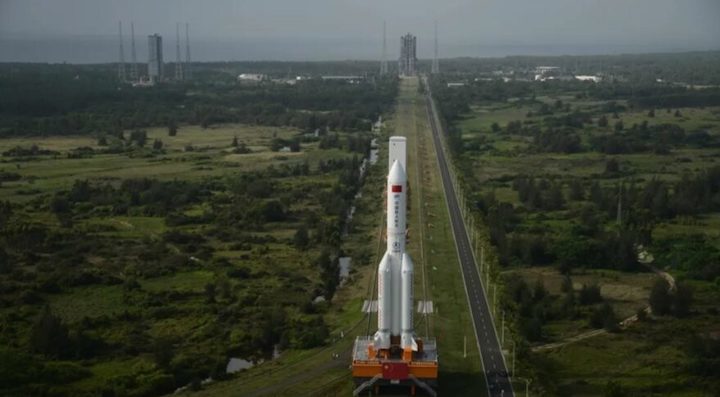
HELSINKI — China is set to launch the first module for its own space station next week after rolling out a Long March 5B rocket at Wenchang spaceport late Thursday.
The 53.7-meter-long Long March 5B is now expected to launch the 22-ton Tianhe space station core module around April 29, although authorities have not officially released a launch time.
The launch will mark the beginning of an intense construction phase for the three-module space station. China plans 11 major launches of modules, cargo and crewed spacecraft across 2021-22.
The Chinese space station was first envisioned in 1992 when China approved its Project 921 to develop human spaceflight capabilities. China sent its first astronaut, Yang Liwei, into orbit in October 2003.
The Long March 5B was transferred to the launch area early Friday local time. The rocket was transferred from a vertical integration building via a 2.7-kilometer track, with the transfer process taking about two and a half hours.
Encased in the payload fairing atop the rocket is the 16.6-meter-long, 4.2-meter-diameter Tianhe core module along with a docking hub. Tianhe and the Long March 5B arrived at Wenchang in February for assembly and integration.
Tianhe, meaning “harmony of the heavens”, is planned to be inserted directly into a low Earth orbit with an apogee of around 370 kilometers and inclined by 41 degrees.
The three-module, 66-metric-ton space station will host three astronauts for six month rotations. Planned experiments include international projects in the areas of astronomy, space medicine, space life science, biotechnology, microgravity fluid physics, microgravity combustion and space technologies.

The Tianhe module will provide regenerative life support and living space for three astronauts as well as propulsion to maintain the orbit of the entire complex.
If launch goes well Tianhe will be visited in May by the Tianzhou-2 spacecraft. Tianzhou-2 will launch via Long March 7 rocket from Wenchang and rendezvous and dock with Tianhe and transfer propellant to the space station module.
The crewed Shenzhou-12 will then send the first astronauts to Tianhe in June. The Shenzhou spacecraft and Long March 2F launcher arrived at the Jiuquan Satellite Launch Center in mid-April.
A Long March 2F rocket and Shenzhou spacecraft will also be on standby at all times at Jiuquan to perform emergency rescue missions to the space station, a senior space official stated in March.
China’s most recent crewed mission was the 2016 month-long Shenzhou-11 mission to Tiangong-2 space lab. The latter was deorbited in 2018, avoiding a repeat of the uncontrolled Tiangong-1 reentry scenario.
The Tianhe mission will be the second launch of the expendable, cryogenic Long March 5B. The first was launched in May 2020. The mission carried a prototype new-generation crewed spacecraft as a payload to simulate launch of the Tianhe module.
The launch of the Tianhe core module was delayed by the 2017 launch failure of the second Long March 5. The saw the postponement of the test launch of the Long March 5B variant for low Earth orbit launches while issues with the YF-77 liquid hydrogen-liquid oxygen engine for the core stage were isolated and remedied.
China has condensed the space station construction schedule into an intensive two-year period, maintaining an earlier target of completing the Chinese Space Station by the end of 2022.
The CSS will also be joined in orbit by the Xuntian optical module, a co-orbiting, Hubble-class space telescope. The space telescope will have a 2-meter-aperture comparable to Hubble but feature a field of view 300 times greater, allowing 40 percent of the sky to be surveyed across a decade.
Xuntian will be capable of docking with the CSS for maintenance and repairs. The space station itself could also be expanded from three to six modules.
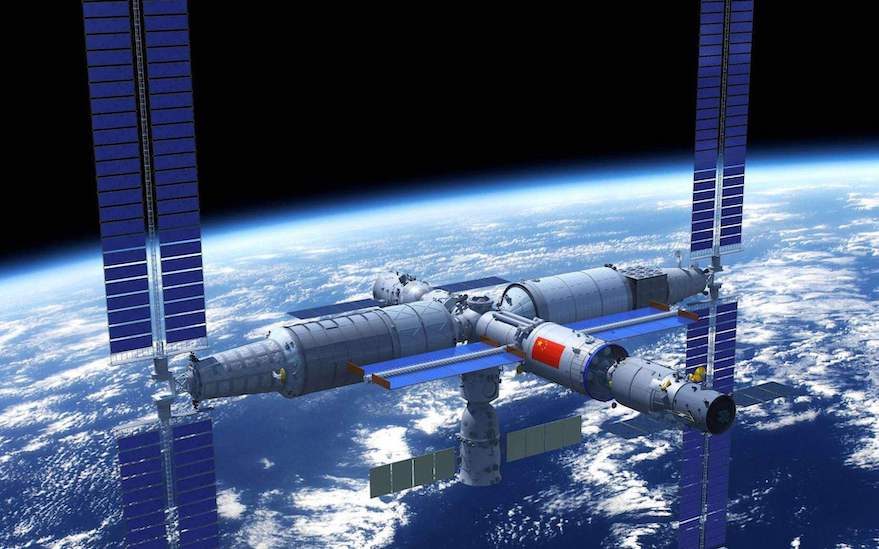
China prepares to launch space station core module
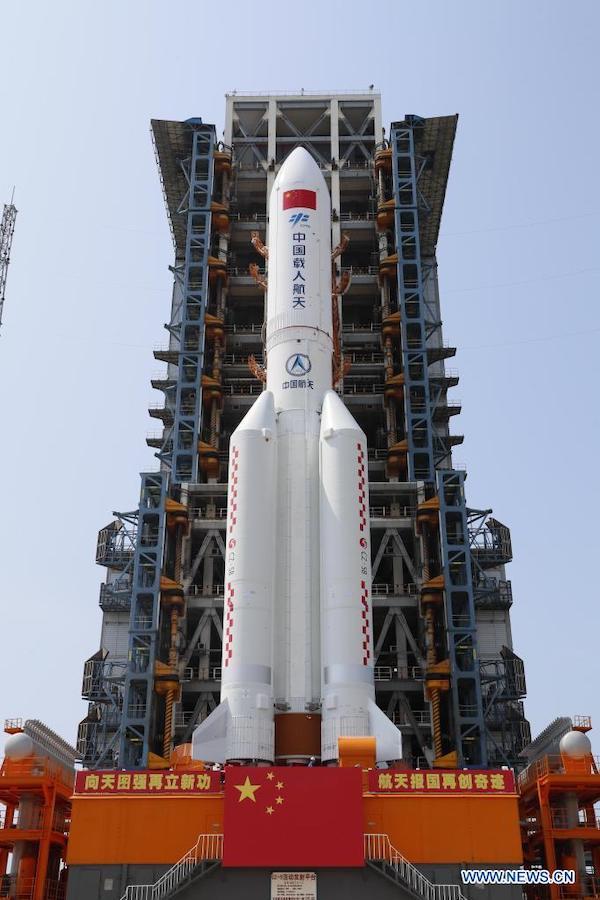
Photo taken on April 23, 2021 shows the combination of the core module of China's space station, Tianhe, and the Long March-5B Y2 rocket after it was transported to the launching area of the Wenchang Spacecraft Launch Site in south China's Hainan Province. The combination will then undergo various pre-launch function tests and joint tests as planned, according to the China Manned Space Agency (CMSA). The facilities and equipment at the launch site are in good condition and preparations have been carried out as scheduled, the agency said. (Photo by Guo Wenbin/Xinhua)
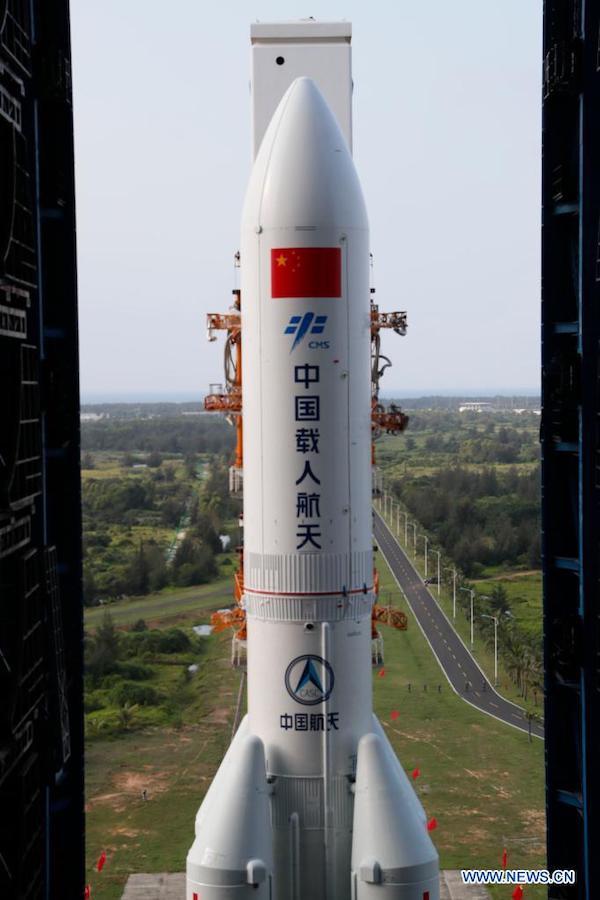
The combination of the core module of China's space station, Tianhe, and the Long March-5B Y2 rocket has been transported to the launching area of the Wenchang Spacecraft Launch Site in south China's Hainan Province on Friday.
The combination will then undergo various pre-launch function tests and joint tests as planned, according to the China Manned Space Agency (CMSA).
The facilities and equipment at the launch site are in good condition and preparations have been carried out as scheduled, the agency said. Enditem
Quelle: Xinhua
----
Update: 29.04.2021
.
China to launch Heavenly Harmony space station core module
China plans to launch the core module for its first permanent space station this week

BEIJING -- China plans to launch the core module for its first permanent space station this week in the latest big step forward for the country’s space exploration program.
The Tianhe, or “Heavenly Harmony” module is set to be hurtled into space aboard a Long March 5B rocket from the Wenchang Launch Center on the southern island of Hainan. The launch could come as early as Thursday night if all goes as planned.
It would be the first of 11 missions to build and supply the space station for a three-person crew.
Here's a look at the planned launch and the past and future of China's space program.
11 MISSIONS PLANNED TO COMPLETE SPACE STATION BY END OF 2022
Another 10 launches will send up two more modules; four cargo supply shipments and four missions with crews. At least 12 astronauts are training to fly to and live in the station, including veterans of previous flights, newcomers and women.
When completed by late 2022, Tianhe is expected to weigh about 66 tons, a fraction the size of the International Space Station, which launched its first module in 1998 and will weigh about 450 tons when completed. Tianhe will have a docking port and will also be able to connect with a powerful Chinese space satellite. Theoretically, it could be expanded with more modules.
Tianhe's main module will initially be about the size of the American Skylab space station of the 1970s and the former Soviet/Russian Mir, which operated for more than 14 years after launching in 1986.
SPACE STATION A LONG-TERM GOAL
China has launched two experimental modules over the past decade in preparation for a permanent station. One, Tiangong-1, which means “Heavenly Palace-1" was abandoned and burned up during an uncontrolled loss of orbit. Its successor, Tiangong-2, was successfully taken out of orbit in 2018.
China began preparations for a space station in the early 1990s as its space program gained momentum. It was excluded from the International Space Station largely due to U.S. objections over the Chinese program’s secretive nature and close military ties.
SPEEDY PROGRESS IN SPACE
After years of successful rocket and commercial satellite launches, China put its first astronaut into space in October 2003. It was only the third country to independently do so after the former Soviet Union and the United States. Since that Shenzhou 5 mission, China has sent other astronauts into orbit, placed crews on the original Tiangong station and conducted a space walk.
It also has increased cooperation with space experts from other countries, including France, Sweden, Russia and Italy. NASA must get permission from a reluctant Congress to engage in such contacts.
China also has pushed ahead with crewless missions, particularly in lunar exploration and has landed a rover on the little-explored far side of the Moon. In December, its Chang’e 5 probe returned lunar rocks to Earth for the first time since the U.S. missions of the 1970s.
MARS ROVER AND FUTURE AMBITIONS
The Tianhe mission comes just weeks before a Chinese probe is due to land on Mars, which would make China only the second country to successfully accomplish that after the U.S. The Tianwen-1 space probe has been orbiting the red planet since February while collecting data. Its Zhurong rover will be looking for evidence of life.
Another Chinese program aims to collect soil from an asteroid, a key focus of Japan's space program.
China plans another mission in 2024 to bring back lunar samples and has said it wants to land people on the moon and possibly build a scientific base there. No timeline has been proposed for such projects. A highly secretive space plane is also reportedly under development.
HOW COMPETITIVE IS CHINA'S PROGRAM?
China's program has advanced in a steady, cautious manner on a carefully designed schedule, largely avoiding the failures seen in the U.S. and Russian efforts when they were locked in intense competition during the heady early days of spaceflight. One recent setback came when a Long March 5 rocket failed in 2017 during development of the Long March 5B variant that will be used to put the Tianhe module into orbit, but engineers moved swiftly to fix the problem.
Critics say China's space program has successfully reproduced the achievements of the U.S. and Russia without breaking much new ground. The country's rising technological prowess may end such talk in coming years. The country may need greater private sector involvement to spur innovation, as the U.S. has done with SpaceX and Blue Origin, and to apply new technologies such as reusable rockets.
Quelle: abcNews
